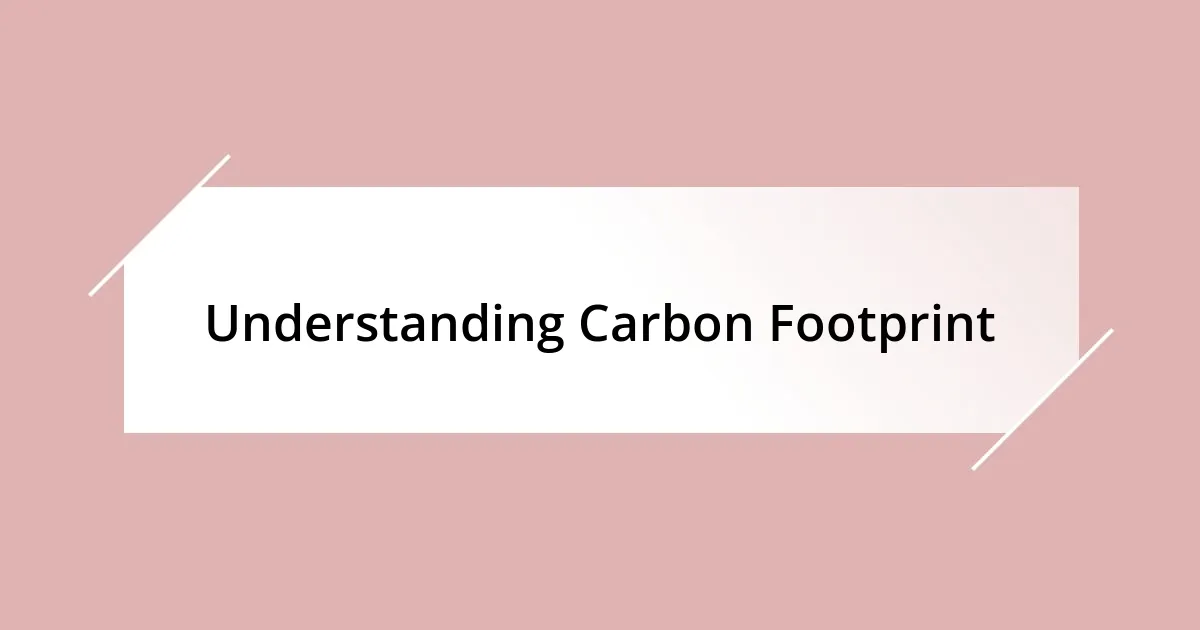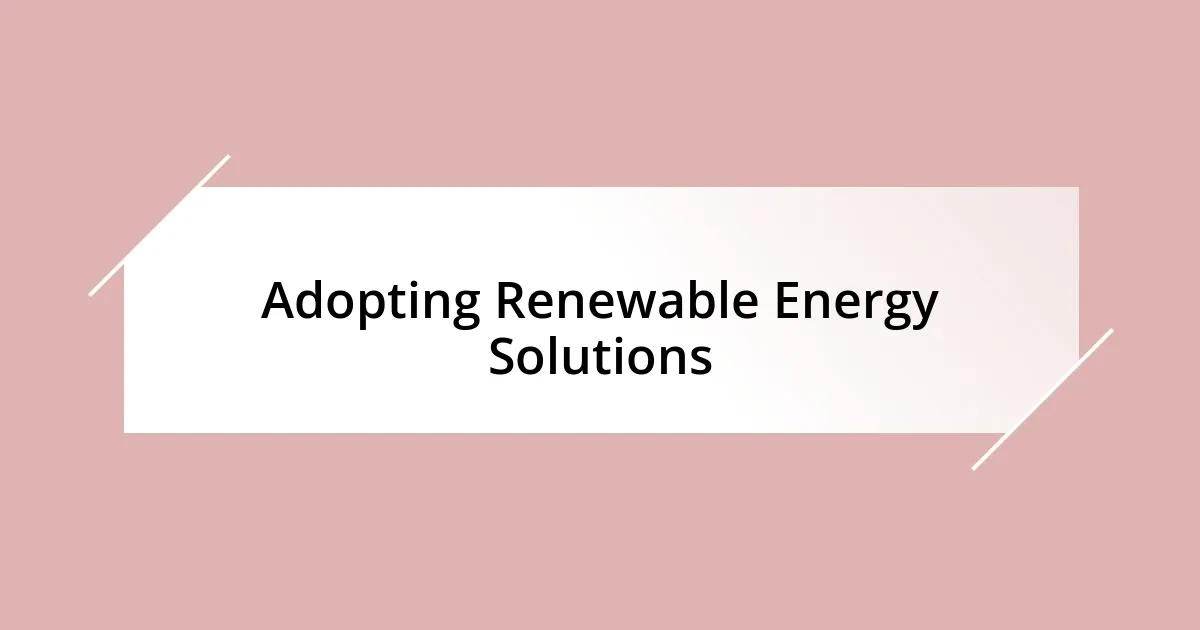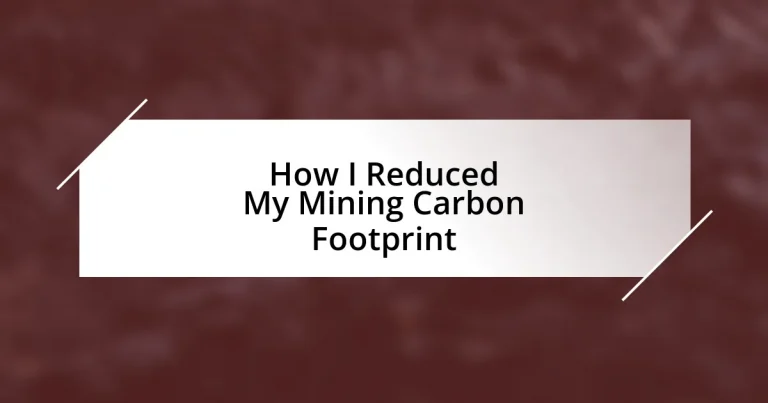Key takeaways:
- Understanding carbon footprint is essential in recognizing the impact of individual and organizational actions on the environment.
- Switching to renewable energy sources, such as solar and wind, leads to significant reductions in emissions and fosters a sustainable mindset among teams.
- Implementing efficient mining practices and regular maintenance can enhance productivity and reduce fuel consumption.
- Tracking emissions and setting ambitious reduction goals motivates teams and drives continuous improvement in sustainability efforts.

Understanding Carbon Footprint
Carbon footprint refers to the total amount of greenhouse gases emitted directly or indirectly by an individual, organization, or activity, measured in carbon dioxide equivalents. When I first learned this, it struck me how every action, from powering machinery to the fuel used in transport, contributes to this footprint. Have you ever thought about how your daily choices impact the environment?
Reflecting on my mining experience, I realized that even small changes could lead to significant reductions in emissions. I remember the day I swapped out conventional diesel with biofuels for some operations; it felt like I was taking a tiny, empowering step towards sustainability. Isn’t it incredible how personal choices can resonate on such a larger scale?
Understanding your carbon footprint is more than just a number; it’s a call to action. I often wonder how many people recognize the hidden emissions in their work practices. Every effort to reduce that footprint brings us closer to a sustainable future, and I’m committed to making each action count. What will you do to lessen your own impact?

Overview of Mining Processes
Mining processes involve a variety of methods to extract valuable minerals from the earth. Each technique can significantly impact the environment, depending on how it’s executed. From surface mining to underground operations, the choices made in each step—from drilling to transporting minerals—play a crucial role in determining the carbon footprint of these activities.
- Surface Mining: Strip mining and open-pit mining are common. They expose the earth’s surface and can result in habitat destruction.
- Underground Mining: Involves tunneling into the earth to reach minerals buried deep. While it minimizes surface damage, it often consumes more energy.
- Mineral Processing: This stage, which separates valuable minerals from waste, can utilize large amounts of energy and water.
I remember the first time I stood on a freshly excavated site, the enormity of the machinery and the sheer volume of disturbed earth left me feeling uneasy. It was then that I truly understood the responsibility we bear in minimizing the impacts of these operations. As I navigated the intricacies of mining processes, I realized that embracing energy-efficient technologies and sustainable practices could foster a more environmentally friendly industry.

Evaluating Energy Sources Used
Evaluating energy sources is crucial in finding ways to minimize our mining carbon footprint. During my own journey, I took the time to analyze the different types of energy powering our operations—traditional fossil fuels versus renewable sources like solar and wind. Honestly, the transformation began when I replaced some diesel generators with solar panels. The initial investment felt daunting, yet the long-term benefits in both cost savings and reduced emissions were undeniable.
I vividly remember attending a workshop where experts discussed the potential of renewables in mining. It felt incredible to see how solar energy could power entire operations. The thought that we could operate sustainably gave me such a sense of hope for the future of mining. A blending of these energy sources not only advanced our efficiency but also helped align our practices with global environmental goals.
In evaluating the energy sources used, it’s important to consider not only the emissions associated with each option but also the availability and feasibility for our specific location. I often reflect on the challenges we faced while implementing these changes, especially in training the team to adapt to new systems. Nonetheless, the collective effort brings a sense of unity and shared purpose in pursuing a greener future together.
| Energy Source | Carbon Emissions (CO2e) |
|---|---|
| Fossil Fuels | High |
| Biofuels | Medium |
| Solar Energy | Low |
| Wind Energy | Very Low |

Adopting Renewable Energy Solutions
Shifting to renewable energy solutions has been one of the most impactful changes I’ve embraced in my mining operations. When I first installed solar panels, I watched as they transformed not just our energy supply but also our mindset. It dawned on me that the clean energy generated wasn’t just about reducing costs; it symbolized a commitment to a sustainable future. Have you ever felt that thrill when making a choice that aligns your work with your values?
During this transition, I was genuinely moved by my team’s enthusiasm. I can still recall the day we powered up our first wind turbine. The sense of accomplishment was palpable—everyone felt like they were part of something bigger. It was more than just energy; it was a shift in culture. Investing in renewable solutions became a catalyst for innovative thinking and collaboration within our team, proving that when we unite for a common cause, we can drive real change.
Exploring options beyond solar and wind also opened my eyes to energy storage solutions. I remember vividly the concern about availability during peak demand times. This prompted discussions with local providers who specialized in battery storage technology. Learning how to maximize energy capture during sunny days for use at night was an enlightening experience. It reinforced my belief that adopting renewable energy isn’t just about the tools we choose but about how creatively we can use them together. How have you considered integrating energy storage in your own projects?

Implementing Efficient Mining Practices
Implementing efficient mining practices goes beyond merely choosing energy sources; it also entails examining and optimizing the way we use resources during operations. I recall a pivotal moment when we re-evaluated our equipment usage and discovered that minor adjustments could lead to significant fuel savings. For instance, by fine-tuning haul routes and adopting a more strategic loading process, we managed to reduce our diesel consumption dramatically. Have you ever taken a step back to analyze the intricate details of your operations? Sometimes, the smallest shifts can yield the greatest rewards.
Then there’s the importance of regular maintenance. I remember a challenging period when we faced unexpected downtime due to machinery failures. It didn’t take long for me to see that the root cause was a lack of preventive measures. By establishing a consistent maintenance schedule, our efficiency improved, and we avoided costly interruptions. It felt like a weight had lifted. This proactive approach solidified my belief that caring for our equipment not only reduces emissions but also enhances productivity.
Lastly, I found that investing in staff training on efficient practices amplified our efforts exponentially. There was one workshop where team members shared their thoughts on energy efficiency, and the discussions sparked innovative ideas I hadn’t considered before. It struck me how empowering our team to contribute to solutions not only increased engagement but also created a culture of sustainability. Have you ever experienced that rush of excitement when your team feels inspired to make a difference? It’s a reminder that everyone plays a crucial role in our collective mission toward reducing our carbon footprint.

Tracking and Measuring Reductions
One of the most satisfying aspects of my journey has been tracking the impact of the changes we’ve made. I decided to implement a dedicated carbon management software that allowed us to visualize our emissions reductions in real time. I’ll never forget the sense of pride that washed over me when I saw our carbon footprint decreasing on the dashboard over the months. It transformed data into a story, and I could nearly feel my team’s collective energy shift as they witnessed our progress. Have you ever experienced that rush of motivation when you see numbers turn into tangible results?
I also took a systematic approach to measuring reductions by conducting regular audits. There was a particular audit that revealed our energy consumption on our largest site was surprisingly higher than anticipated. It felt like a challenge, yet I knew it was also an opportunity for growth. By engaging the team in discussions about those findings, we brainstormed innovative, actionable strategies to lower consumption. I’ve learned firsthand that sharing the information not only boosts accountability but ignites a collaborative spirit; how can one person take ownership of a vision without involving others in the journey?
Lastly, I focused on setting achievable yet ambitious goals for our reductions. For instance, I vividly recall setting a target to lower our CO2 emissions by 25% within a year. It felt daunting, yet exhilarating at the same time. Collaborating with the team to break down this goal into smaller milestones created a buzz in our operations. Tracking these achievements provided constant reminders of our purpose. Isn’t it incredible how setting clear targets can galvanize a group to reach for something greater? Each small victory reinforced my belief that measuring progress is as crucial as the actions we take.

Case Studies of Successful Reforms
Some of the most transformative changes I’ve witnessed stem from companies completely overhauling their waste management practices. One operation decided to adopt a circular economy approach, which meant finding ways to reuse byproducts and minimize waste. I remember attending a conference where a representative proudly shared their experience of turning what was once considered waste into a valuable resource for local construction projects. Listening to their journey made me think: how often do we overlook opportunities right beneath our feet simply because we follow the same old paths?
Another striking example comes from a mining operation in a more remote area that switched to renewable energy sources, specifically solar panels. I had the chance to visit this site and was astounded by their innovation. Witnessing the transformation of a once heavily fossil-fuel-dependent operation into one that now boasts a significant portion of its energy from solar was truly inspiring. It sparked an important conversation: could adopting similar practices make renewables a feasible option even for more conventional setups?
Lastly, a colleague of mine implemented a rigorous emissions tracking system that utilized drones for monitoring. I recall our first discussion about this technology, where I was skeptical about its practicality. Fast forward a few months, and I saw how it not only improved accuracy in identifying emissions sources but also boosted morale among team members who felt empowered by using cutting-edge tools. Reflecting on that experience, it begs the question – how can embracing new technologies drive innovation and reduce our industry’s carbon impact?














